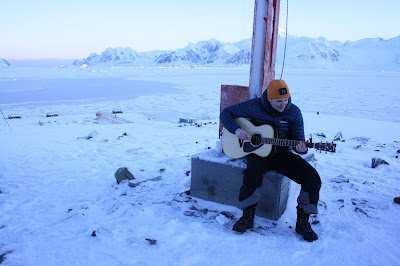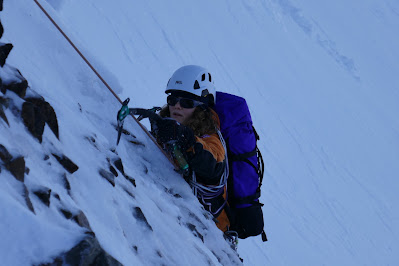To celebrate the return of the sun, a ceremony ensued last Friday which accompanied the first sighting of a warm light above our horizon. Those who encountered the glow of the sun on their face (when out climbing in the local travel area on Reptile Ridge) didn't realise just how much they had missed it. In stark contrast to the last 56 days of very dim light, the mountains and islands now glow pink and orange when bathed in sunlight. The sun is something that, like many, I took for granted, I have never experienced a day without it. I saw it for the first time, since it disappearance, on Tuesday after lunch for all of 10 minutes as it crept above a mountain. It's almost sunglasses weather!
Robbie, the youngest member on station, performed 'Elephant Stone' by the Stone Roses on the guitar. In keeping with tradition, he hoisted the union jack flag back into the air to mark the return of the light. For this ceremony the wind was low with temperatures of -13°C (quite different from the -20 °C we experienced during the sundown ceremony (read here!)... although his fingers were still quite numb by the end! There was a general merry feeling amongst everyone, embracing the longer days and return of the sun's energy.

Robbie playing Elephant Stones with bare hands

The return of the sun is met with displaying the union jack flag
A proud moment for young Robbie!
It is traditional to accompany speeches with whisky toasts
To accompany the 'sun up', the second round of winter trips are about to start (an explanation of what winter trips are and the preparation prior to my first trip are described here).
My second trip will take place in late September. Together with two field guides and the station leader, we are planning a hauling expedition (essentially towing a ~100kg carbon fibre sledge) to a peak called Sighing. I have been practicing the hauling technique, finding the right shoes and increasing the load of my pulk (the sledge in tow) over these last few weeks. During one particularly training, I was sweating through my thin base layers whilst being outside in -20 °C! During the first few sessions, the snow was not too deep but this weekend, we experienced a snow dump of about 30 cm. Saturday's training was significantly more difficult, it felt more like pulling a sledge through treacle than sliding over a thin compact, icy layer.
Hauling around our local travel area, Photo credit- Mark Chambers
Frozen eyebrows, hair, hat and eyelashes, Photo credit- Mark Chambers
The sledge in tow, perspective from the hauler
During my training, I went to visit an igloo that we had built a few weeks back. It was still standing strong, much to my amazement.
Visiting the igloo 3 weeks post build
Igloo building back in late May- Photo credit, Pete Hill
A pyramid tent and an Igloo- Photo credit, Pete Hill
During the first round of winter trips, two field guides, Mark and Ed, the electronics engineer, Jas and the marine assistant, Ryan, completed a hauling trip to Sighing Peak.
Jas, Ryan, Ed and Mark posing for the photo in full hauling attire- Photo credit: Jaskiran Nagi
Better late than never (I hope!), I would like to share some photos from my first winter trip in May. The winter trips are organised in pairs. I was with Pete, the boating officer, his field guide, Mark and my field guide Ed. The timing of winter trips are very much luck of the draw and largely governed by the weather. Friends on trips before ours were stuck in their tent for 3-4 days! We were the last trip to go out and therefore had minimal daylight (~6 hours).
For our trip, the weather was not on our side with strong winds and blowing snow, unsuitable conditions to build camp and install pyramid tents. We spent the first few days taking refuge in 'the caboose' just out of view from station. We made it cosy and spent time warming soup and camembert, playing card games, watching the weather from our window and receiving radio updates from station. The weather died down by the second day and Ed and I traversed Stork Ridge (a magnificent landscape of three peaks), only stopping for rapid breaks of hot Ribena and wine gums and then moving swiftly on to avoid getting too cold. May is the heart of winter and we were experiencing a week of very cold temperatures. By this point, we decided to cut our losses with setting up a tent and made the caboose our new homely base.
Our home for the week, the Caboose- Photo credit: Pete Hill
I particularly enjoyed probing the ground to locate a known crevasse and with everyone chipping in for digging shifts, we revealed a great ~20 m deep crater. The field guides set up anchors and we abseiled into a wonderfully silent and breath-taking opening below the ground. On our way out, climbing up the vertical and narrow walls was hard work and certainly made my forearms burn!
Exploring a crevasse- Photo credit: Pete Hill
I particularly enjoyed days out climbing peaks such as Orca, N2 (a coastal mountain), Little Jim and Reptile Ridge. We experienced a range of conditions from beautiful clear skis to sudden low cloud accompanied by snow.
Climbing a peak called Orca- Photo credit: Pete Hill
Full mountaineering gear needed: crampons, ice axes, climbing harness and snow stakes- Photo credit: Pete Hill
Ed and I admiring the view from Orca- Photo credit- Pete Hill
Abseiling down Orca- Photo credit: Pete Hill
Coming back to station after only one week of being away felt surreal. The change of scenery and a week of adventure gave me the impression of having been away for a month. Until then, I didn't quite value the importance of having a different view, and as habitable and enriching station life is, being away from it was important. I appreciated it even more upon our return - helped, no doubt, by the welcome back party to celebrate the first round of winter trips!
Reptile Ridge under a dusting of stars- Photo credit- Pete Hill






















This comment has been removed by a blog administrator.
ReplyDeleteThis comment has been removed by a blog administrator.
ReplyDelete